What a Baby Should Be Able to Do in the First Months of Their Life
5-Minute Crafts learned about what skills a baby needs to develop during the first year of their life and we are going to share this info with you.
❗ This article is for informational purposes only and describes approximate skills that a baby might have by the age of 1. The individual development of your baby can only be assessed by a doctor.
First month after birth
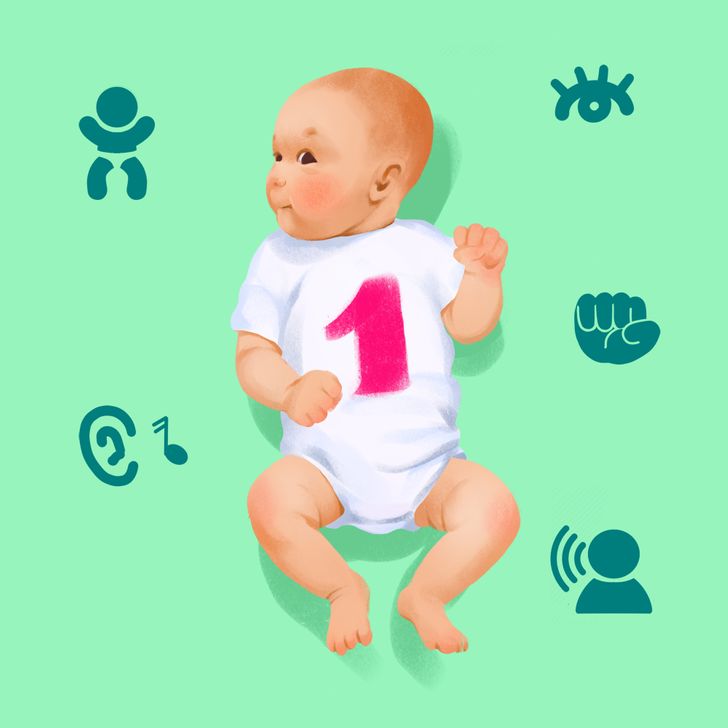
- Primitive reflexes like sucking, grasping, swallowing, and some others are developed.
- The baby makes sharp jerky movements with their hands, squeezes their fingers into fists, and brings them to their mouths and eyes. They can turn their head while lying down.
- The baby can catch the rhythm and melodies of speech, recognize their mother’s voice as well as some other sounds, and startles to sudden and loud sounds.
- The baby can hold their gaze at an object located at a distance of 8-12 inches away and follow a slowly moving object.
- The baby now recognizes the smell of their mother’s milk and uses crying as a way to get attention. This cry sounds the same in all cases.
2 months
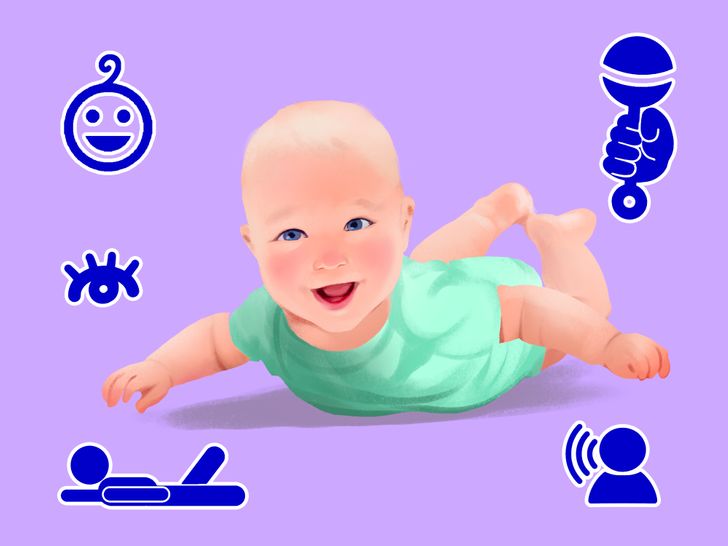
- The baby pays attention to faces, they can turn their head to the sound of a voice or any other sound, they can reply with a smile to a smile.
- Their movements become smoother and less chaotic. The baby can lift their head in a lying position and push up when lying on their tummy.
- Fingers are no longer clenched into fists all the time and their palms can be open for about 50% of the time. Also, by this time, the baby is usually able to hold a rattle in their hand.
- The baby opens their mouth when they see breasts or a bottle, they recognize their mother, track big and contrasting objects, and can suck their thumb.
- The baby starts to babble by pronouncing some vowel-like sounds.
3 months
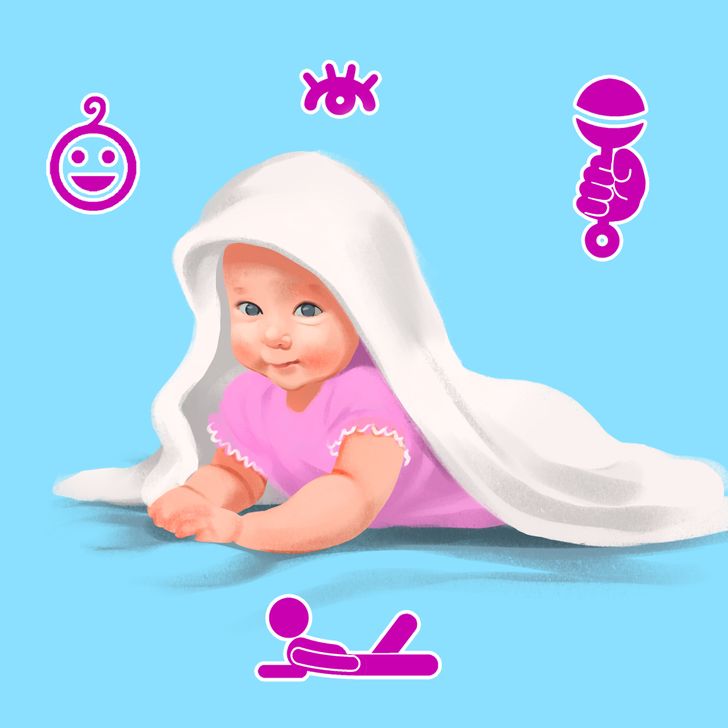
- The baby lifts their head and chest while lying on their tummy and supports the upper part of their body while leaning on their arms. They can stretch their legs and make pushing movements when lying on their tummy or on their back. When their feet touch a surface, the baby bounces back from it.
- Fingers can now easily clench and de-clench. The baby often brings their hands to their mouth, stretches to objects that they see, and picks up rattles in their hands and shakes them.
- By this age, the baby becomes more attentive and sociable. They closely monitor moving objects, peer into the faces of those around them, and recognize people and objects. They enjoy playing with adults and may cry, expressing dissatisfaction if the game stops. When someone talks to the baby, the baby may respond by humming.
- Some babies start to laugh by 3 months.
4 months
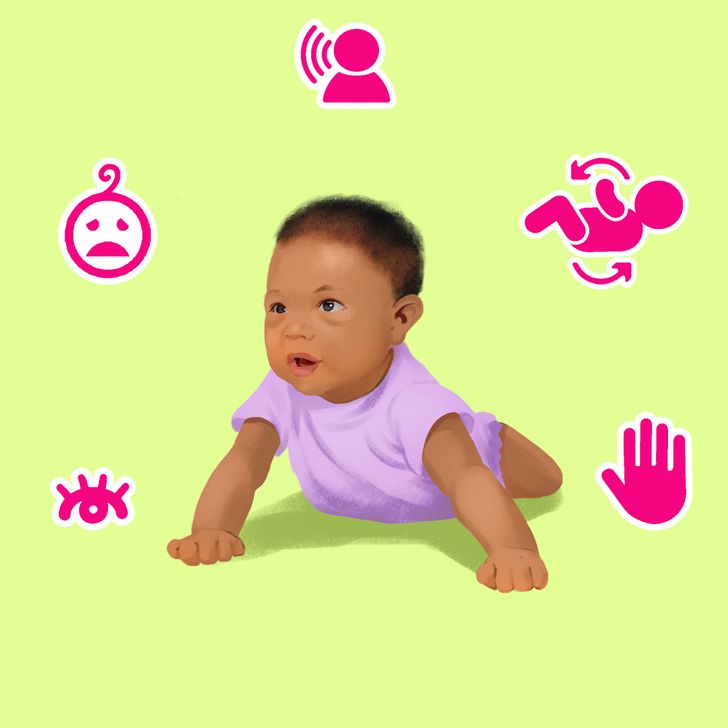
- The baby smiles often, copies some movements and facial expressions of those around them (like a smile or a frown, for example). They actively babble, using mimics, and try to repeat the sounds that they hear.
- The baby becomes more emotional: they cry in different ways when they are hungry, when they feel pain, or when they are tired. They actively express their mood and show affection.
- By month 4, the baby can hold their head on their own normally, roll over from tummy to back, and sit up (but with someone’s support).
- They develop more awareness of their own actions. They can stretch out to a toy with one hand in a persistent manner. They closely monitor objects that are moving from side to side, draw attention to new faces, and study them.
- The baby investigates their parents’ faces as well as their own body — especially their eyes, hands, and mouth.
- They can ’talk’ to themselves while alone, laugh loudly, and calm down when hearing their parents’ voices.
5 months
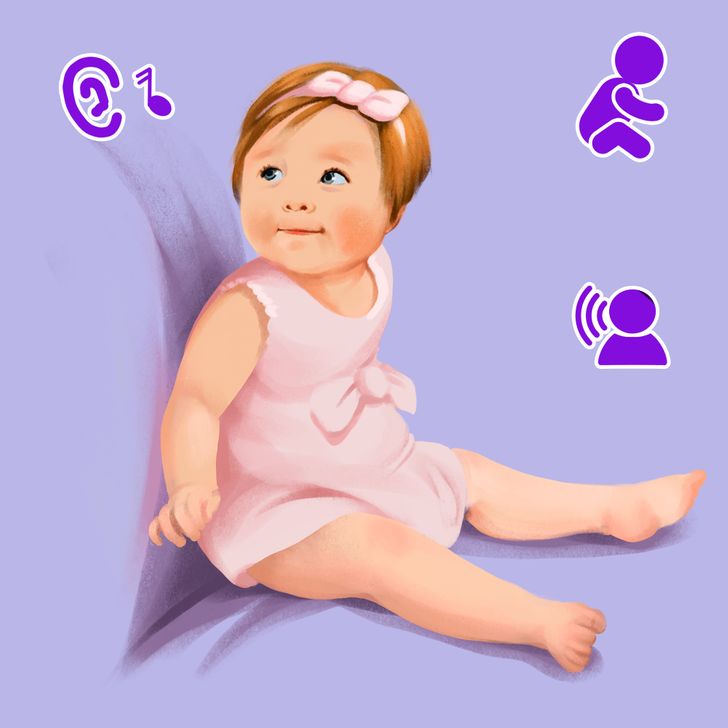
- By the age of 5 months, the baby can sit with slight support, help themselves with their hands, transfer objects from one hand to the other and bring them to their mouth.
- From the age of 5 months, the baby can already recognize and respond to their name and express dissatisfaction with other sounds besides crying.
6 months
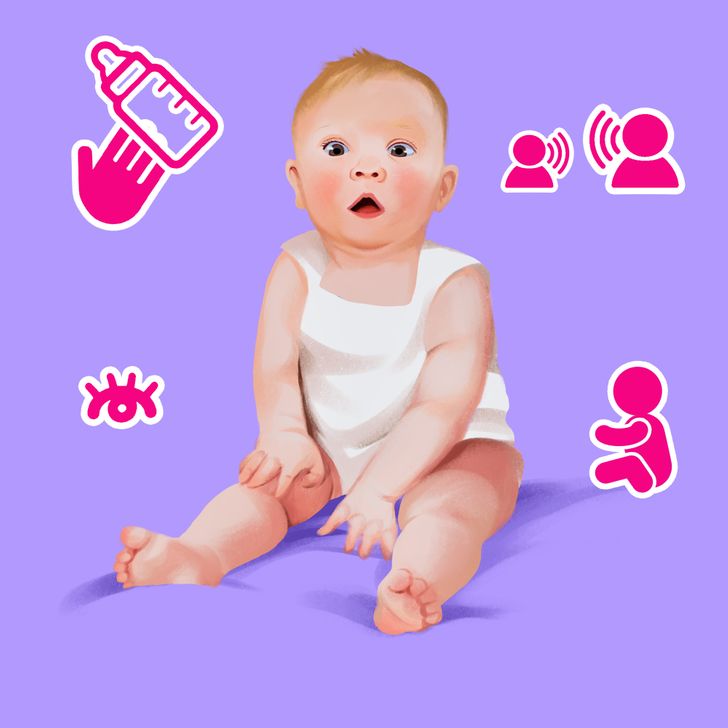
- The baby can now roll over from tummy to back and vice versa by themselves, transfer weight on one hand when lying down, and start to sit without support.
- The baby can now support a conversation: they can listen when an adult is talking to them and respond when they stop. They can react to sounds by making their own sounds and reply when they hear their name. They start to pronounce their first consonants such as “m” and “b” and combine them with vowels (“ah,” “eh,” “oh”).
- By this age, the baby already knows familiar faces, and can accurately identify a stranger and show concern about this. They like to look at themselves in the mirror.
- By this age, the child begins to actively show curiosity: to examine objects located nearby, try to reach something with one hand, grab their bottle, etc. Also, they can hold one object in one hand, and another object in the other.
7 months
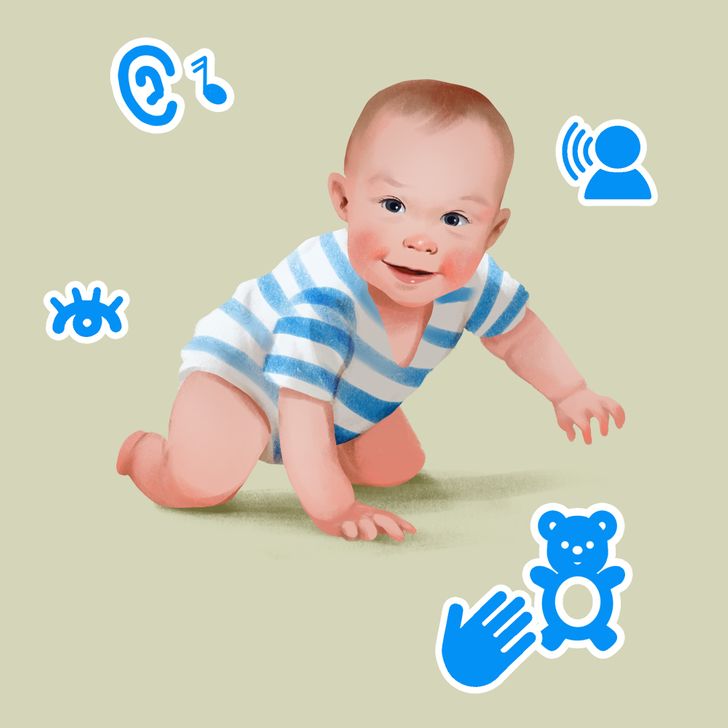
- Sitting without support becomes more stable. By the age of 7 months, the baby develops full-color vision. They are already quite good at distinguishing objects in the distance and tracking moving objects.
- Not only does the baby react to their name but they can also distinguish emotions by the tone of someone’s voice. They also respond to refusals, babble “words” made up of consonant chains, and actively use their voice to express joy or displeasure.
- The baby listens to music with pleasure and looks toward a familiar object when someone names it. They can look from the object to the parent and back if they need help (for example, to play with a wind-up toy). They try their best to get objects of interest that are out of reach.
8 months
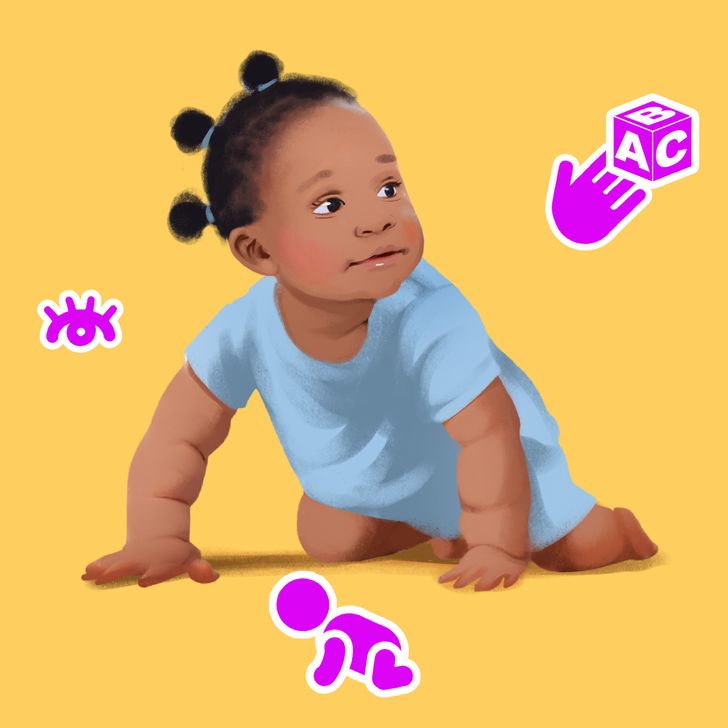
- Oftentimes, the baby can crawl by this age, can stand in a kneeling position, and get into a sitting position themselves.
- The child can perform simple actions with objects like holding a bottle, taking a cube out of a bowl, and so on.
- By this age, the baby pays attention to where the adult is looking — when the parent looks away, the child follows them. Also, this little human can search for objects that have fallen on the floor, shake their head in refusal, find family members by looking at them, answer simple questions such as “Where is your mom?”, and so on.
9 months
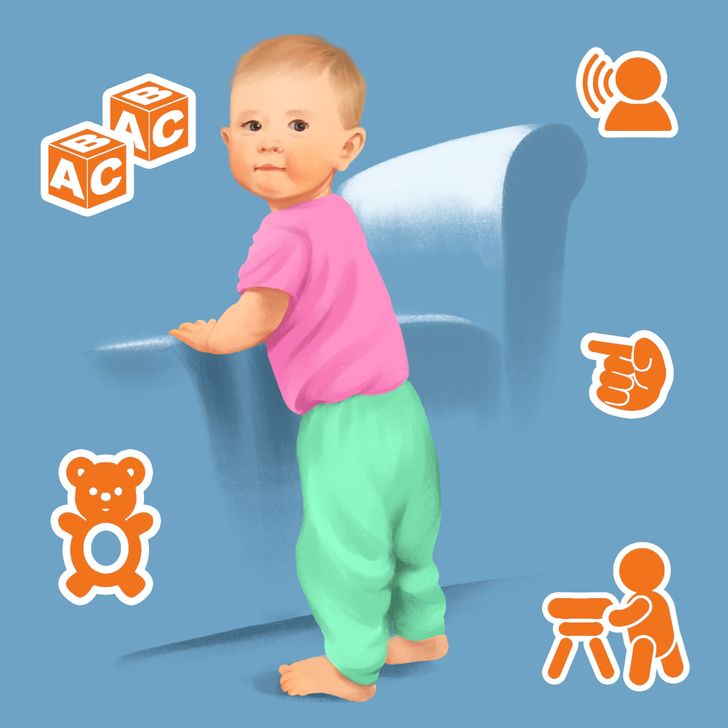
- By the age of 9 months, most kids can repeat sounds they hear, mimic the rhythm of other people’s voices, pronounce simple words like “mama,” and wave their hands when they are asked to say goodbye. They can also point their fingers at objects that they are interested in.
- The baby may be afraid of strangers and be very clingy to familiar adults. Usually by this time they already have favorite toys.
- The baby creeps on their hands and knees, tries to stand up themselves, and can stand holding onto something.
- They can pick up small objects, play games with gestures such as “coo-coo” and various objects like knocking cubes into each other, ringing a bell, pulling a string, etc.
10 months
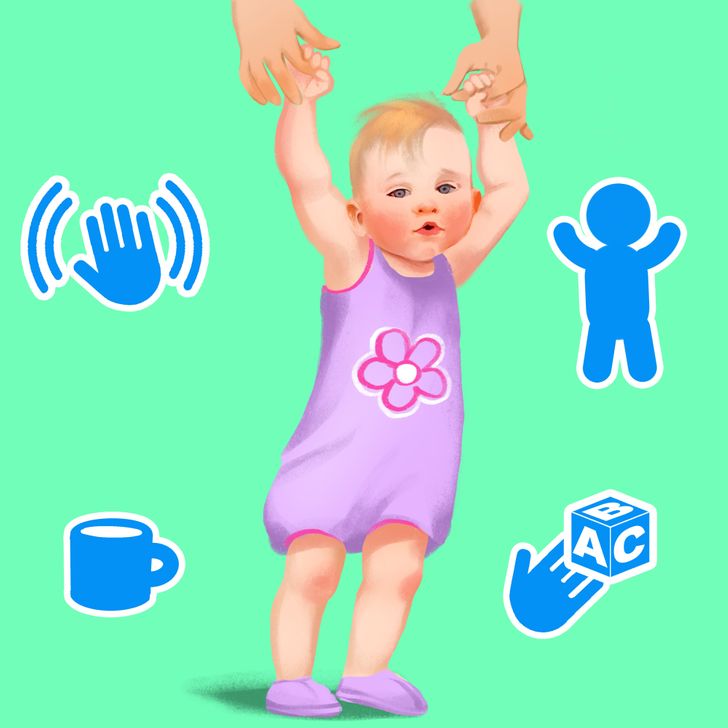
- By the age of 10 months, the baby can crawl well, they can go around furniture holding onto it with both hands, and stand holding onto an object with one hand only. The baby can now walk short distances with the help of an adult and with both-hand support.
- Oftentimes, by this age, babies are already actively using their index finger, pointing at various objects, and are able to drink from a cup, not just from a bottle.
- The baby can find a toy hidden under a cloth and spy on adults. They react to the phrase “Bye!” by actively waving their hands.
- Some kids can identify each of their parents by 10 months (they can match the word and the person), they can also start fulfilling small requests like “give me the toy, please”. Other kids won’t learn to do this until the age of 12 months.
11 months
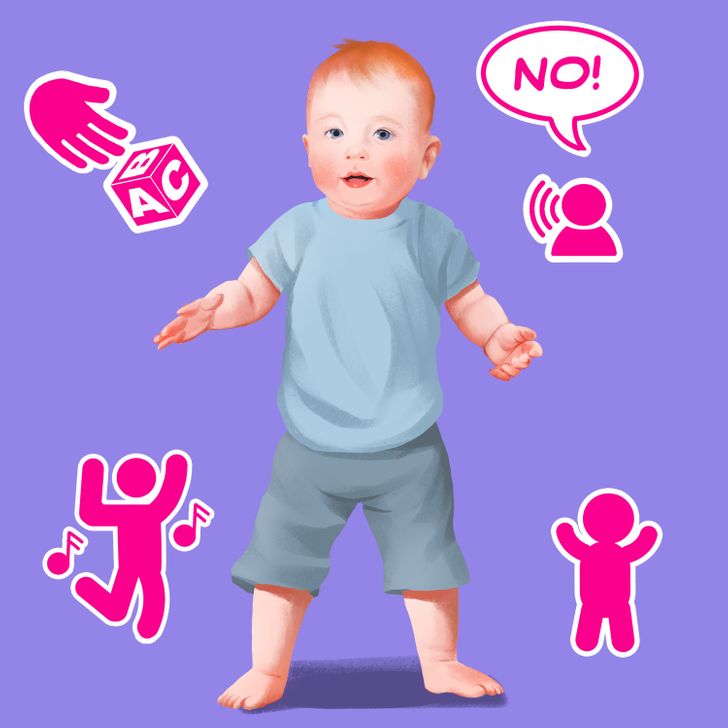
- Closer to the age of 1, the child can turn around in a sitting position and move around, holding on to the furniture with one hand. By this time, many babies are already able to stand on their own for a few seconds and walk, holding onto their parent’s hand (one hand support).
- During a game, the kid can throw objects, give one of them to the parent when the adult asks them to do it.
- By the age of 11 months, the baby starts to show interest in pictures in books, actively moves along with music, and “sings along” with songs using vocalization.
- Also, by this time, many babies can stop their actions when they are told “No!”
1 year
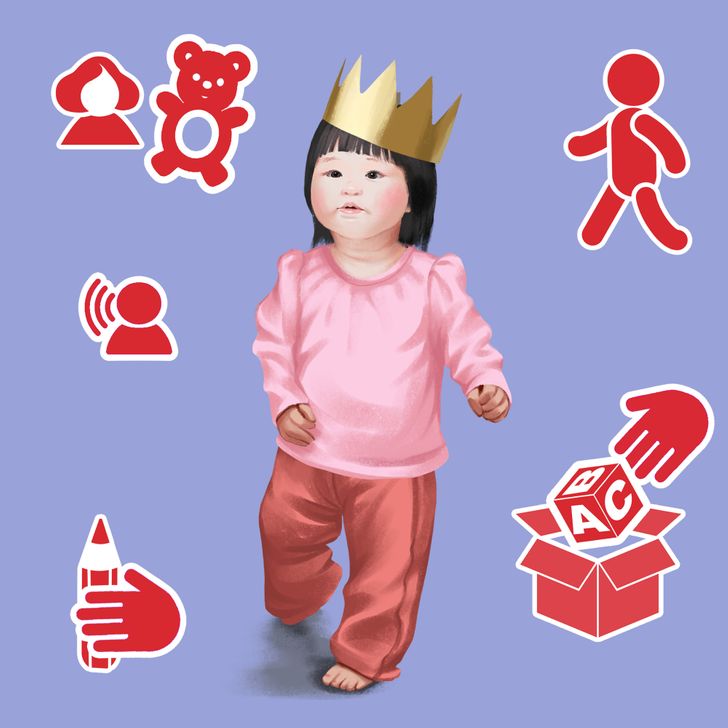
- By the age of 1, the baby has favorite things and people who they strive to spend more time with. The baby will often cry when the mother or father is leaving, behave cautiously with strangers, and even show fear in some cases.
- The baby can perform some actions without anyone’s help, like putting toys into a container, getting toys out of the toy box, drinking from a mug, combing their hair, etc. They explore objects in different ways like shaking, throwing, and banging them together.
- The baby can find hidden things and match an object and a picture when it’s named. They can hold a pencil and doodle on paper, build a tower from 2 bricks, give a book to their parent if they want to listen to a story from this book.
- They can put out a leg or an arm at their parents’ request to help with dressing.
- The child is able to repeat sounds and actions in order to attract someone’s attention, make sounds with changes in tone, as if imitating real speech. They can copy the gestures of adults and try to repeat words that parents use. By the age of 1, the baby can usually say a few words besides “mama” and “dada.”
- By this time, most children are able to take several steps themselves and move freely, while holding onto furniture.
Share This Article